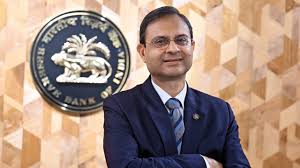
RBI Governor Calls for Growth-Oriented Monetary Policy Amid Falling Inflation

 :
| Updated On: 21-Jun-2025 @ 1:23 pm
:
| Updated On: 21-Jun-2025 @ 1:23 pmSHARE
At the June 4–6, 2025 meeting of the Monetary Policy Committee (MPC), Reserve Bank of India (RBI) Governor Sanjay Malhotra emphasized the need for monetary policy to support economic growth while maintaining price stability, especially in light of a sharp decline in retail inflation. The minutes released on June 21 revealed that the MPC voted 5:1 to reduce the repo rate by 50 basis points (bps), bringing it down to 5.5%. The policy stance was also shifted from “accommodative” to “neutral.” Following this decision, banks across the country began lowering lending and deposit rates, potentially easing financial conditions for consumers and businesses.
Malhotra justified his support for the significant rate cut by pointing to the substantial drop in inflation—from 6.2% in October 2024 to 3.2% in April 2025—and the revised projection of 3.7% inflation for 2025–26, which is lower than the RBI’s April forecast. He noted that this reduction in inflation, combined with a consistent growth forecast of 6.5%, creates room for the central bank to support investment and consumption by reducing borrowing costs. He emphasized that a front-loaded rate cut would send a strong signal of monetary policy support to economic agents and help reinforce liquidity certainty in the system.
RBI Deputy Governor Poonam Gupta echoed Malhotra’s views, arguing that current macroeconomic conditions provide both the need and space for rate reductions. She suggested that while gradual rate cuts of 25 bps in successive cycles could have been an option, a 50 bps front-loaded cut would be more effective in ensuring faster monetary transmission and offering clear policy direction. Gupta noted that this approach would help mitigate uncertainties from the global economic environment.
However, external MPC member Saugata Bhattacharya opted for a more cautious stance, voting for only a 25 bps cut. He cited persistent uncertainties and high volatility in the global economy, highlighting that the MPC statement mentioned “uncertainty” and “volatility” six times. Bhattacharya argued that such conditions warranted a measured and prudent approach to easing monetary policy, as overly aggressive cuts could destabilize expectations.
On the other hand, another external MPC member, Nagesh Kumar, supported the full 50 bps cut. He argued that a stronger-than-expected rate reduction, paired with potential fiscal support, would send a clear message about India’s commitment to sustaining economic growth. Kumar emphasized that such a move could significantly reduce lending rates and boost investment in durable goods, spurring overall demand and economic momentum.
Rajiv Ranjan, MPC member and RBI Executive Director, added a note of caution, warning that combining a large rate cut with an accommodative policy stance might mislead financial markets about the likelihood of further easing, potentially triggering volatility. He clarified that while the policy stance has been shifted to “neutral,” it does not imply a change in the overall direction of monetary policy but rather provides flexibility to adapt to evolving macroeconomic conditions.
Overall, the MPC’s decision marks a significant move to support India’s growth amid a more favorable inflation outlook, while balancing the need for market stability and signaling measured intent.